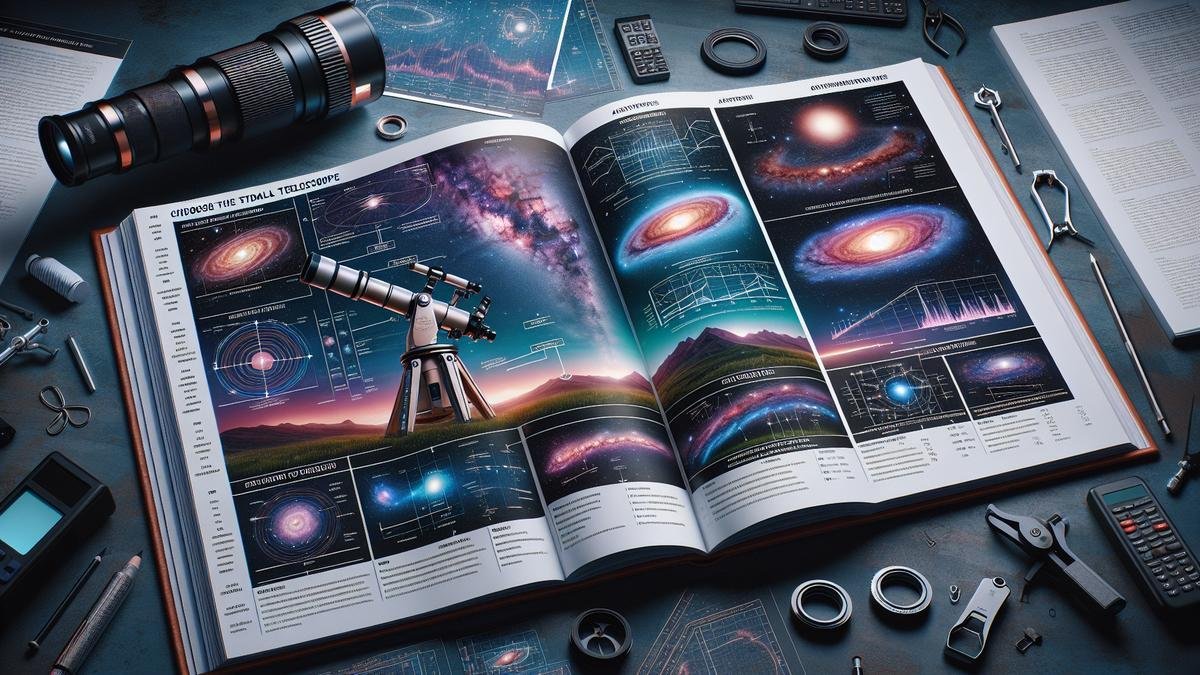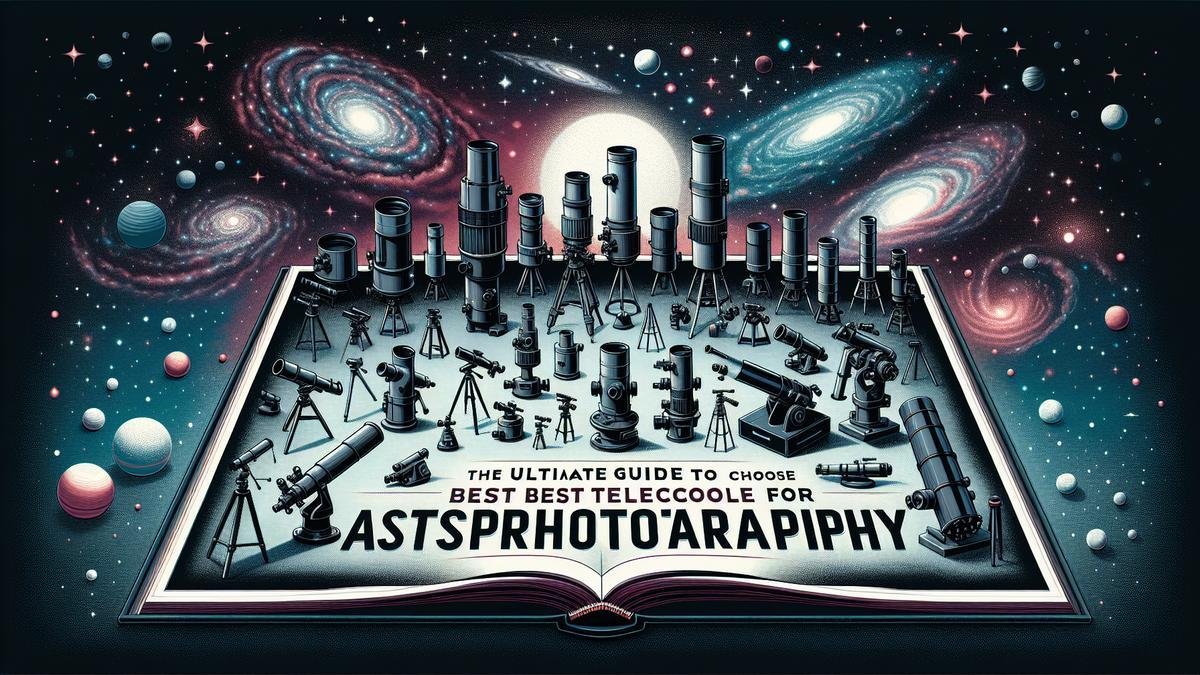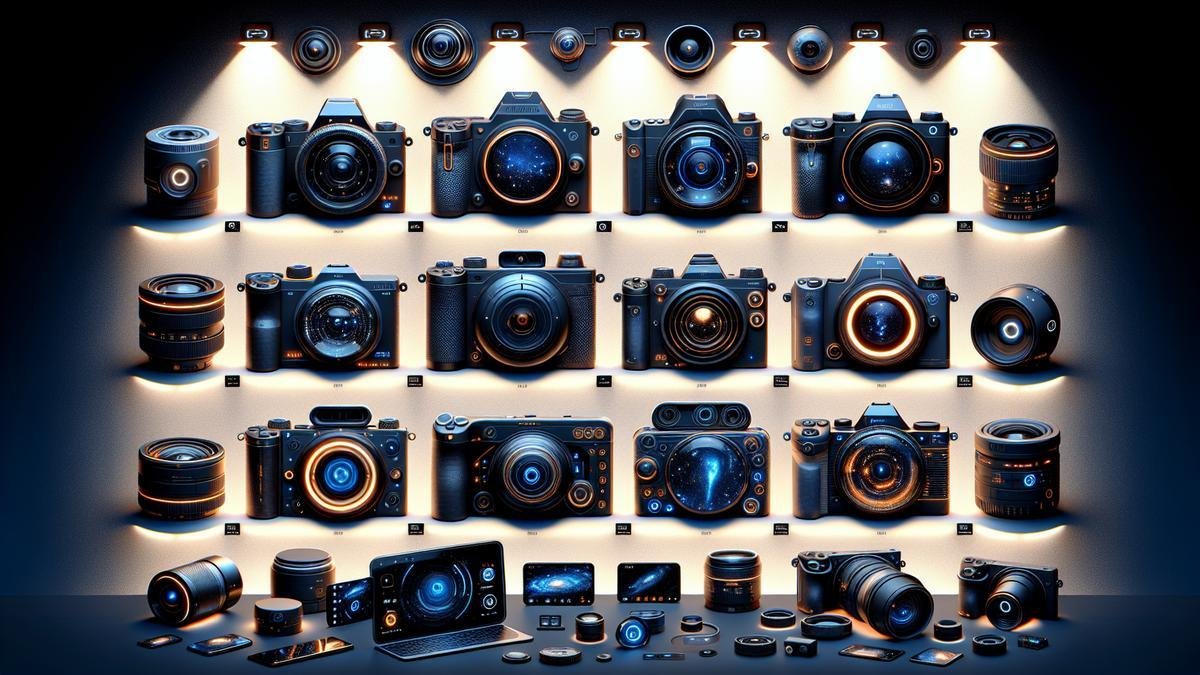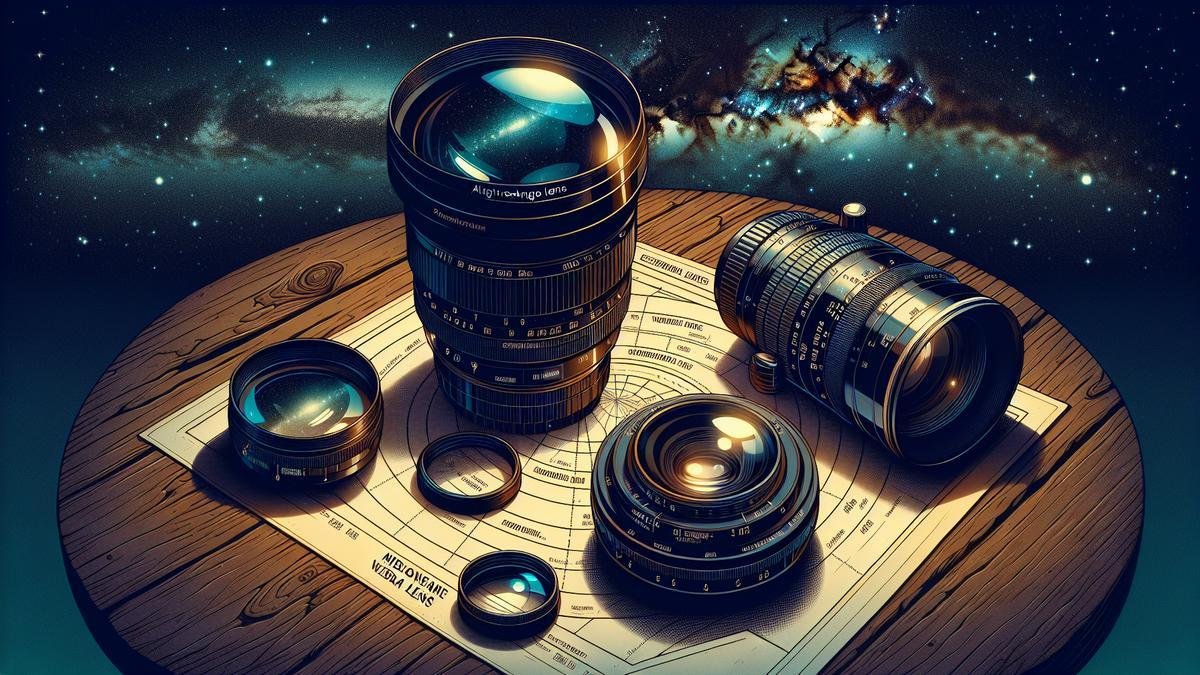The Ultimate Guide to Choosing the Best Telescope for Astrophotography will take you on a stargazing journey like no other. Whether you’re new to skywatching or a seasoned star snatcher, understanding different telescopes, from refractors to reflectors and catadioptric designs, is key. You’ll discover essential features like aperture size and focal length and explore budget-friendly options, all while learning about must-have accessories for capturing mesmerizing celestial snapshots. Well even dive into maintenance tips to keep your telescope in top shape and share secrets for stunning astrophotography, making this guide your cosmic companion in the world of telescopes!
Key Takeaways
- Consider the telescope’s aperture size.
- Reflectors are great for beginners.
- Refractors offer sharper images.
- Compound telescopes are versatile.
- Set a budget before shopping.

Understanding Different Types of Telescopes
When you’re diving into astrophotography, selecting the right telescope is crucial. It’s like choosing the perfect brush for a masterpiece. Each type of telescope has its own strengths and weaknesses, and understanding these can help you make an informed decision. Let’s break down the different types of telescopes available, so you can find the best one for your astrophotography needs.
Refractor Telescopes
Refractor telescopes are the oldest type of telescope, and they use lenses to gather and focus light. These telescopes are known for their straightforward design and ease of use. Heres a quick breakdown:
Advantages:
- Excellent Image Quality: Refractors produce sharp and high-contrast images, making them ideal for capturing detailed photos of planets and the moon.
- Low Maintenance: With sealed optics, they require less cleaning and maintenance compared to other types.
- Durability: These telescopes are robust and can last for years with proper care.
Disadvantages:
- Cost: High-quality refractors can be expensive, especially those with larger apertures.
- Chromatic Aberration: Cheaper models may suffer from color fringing around bright objects.
Best For:
- Planetary Photography: Their sharp image quality makes them perfect for photographing planets.
- Lunar Photography: They excel at capturing the intricate details of the moons surface.
Heres a simple table to summarize:
| Feature | Refractor Telescopes |
|---|---|
| Image Quality | Excellent |
| Maintenance | Low |
| Durability | High |
| Cost | High (for larger apertures) |
| Best For | Planets, Moon |
Reflector Telescopes
Reflector telescopes use mirrors instead of lenses to gather and focus light. They are a popular choice for many astrophotographers due to their versatility and affordability.
Advantages:
- Cost-Effective: Generally cheaper than refractors for the same aperture size.
- No Chromatic Aberration: Reflectors dont suffer from color fringing.
- Large Apertures: You can get a larger aperture for less money, which is great for deep-sky photography.
Disadvantages:
- Maintenance: Mirrors need regular collimation (alignment) and cleaning.
- Bulky: They can be large and cumbersome, making them less portable.
Best For:
- Deep-Sky Photography: Ideal for capturing galaxies, nebulae, and star clusters due to their large apertures.
- General Use: Versatile enough for both planetary and deep-sky photography.
Heres a table to help you compare:
| Feature | Reflector Telescopes |
|---|---|
| Image Quality | Very Good |
| Maintenance | High |
| Durability | Moderate |
| Cost | Moderate |
| Best For | Deep-Sky, General Use |
Key Features to Look for in a Telescope
If you’re diving into the mesmerizing world of astrophotography, choosing the right telescope can feel like navigating a starry labyrinth. Let’s break it down, so you can make an informed decision that aligns with your celestial aspirations.
Aperture Size
The aperture size is the heart of your telescope. Think of it as the window through which your telescope gazes into the cosmos. The larger the aperture, the more light it gathers, and the clearer and brighter your images will be. Here’s a quick guide:
| Aperture Size | Best For |
|---|---|
| 70-100mm | Beginners, Moon, Planets |
| 100-150mm | Intermediate, Nebulae, Galaxies |
| 150mm+ | Advanced, Deep Sky Objects |
A larger aperture means more detail and light, but it also means a heavier and more expensive telescope. For beginners, a 70-100mm aperture is a great start. As you advance, you might crave the clarity that a 150mm or larger aperture can provide.
Focal Length
The focal length of your telescope determines its magnification power. It’s the distance from the telescope’s primary lens or mirror to the point where the light converges to form a sharp image. Here’s a simple breakdown:
| Focal Length | Magnification Power | Ideal For |
|---|---|---|
| 400-800mm | Low to Medium | Wide-field views, Star Clusters |
| 800-1500mm | Medium to High | Planets, Moon |
| 1500mm+ | Very High | Detailed views of Planets, Small Deep Sky Objects |
A shorter focal length offers a wider field of view, perfect for capturing expansive areas like star clusters or the Milky Way. A longer focal length, on the other hand, provides higher magnification, ideal for zooming in on planets or the moon.
Mount Types
The mount is the backbone of your telescope setup. It holds the telescope steady and allows you to track celestial objects as they move across the sky. There are two primary types of mounts: Altazimuth and Equatorial.
Altazimuth Mount
An Altazimuth mount moves up-down (altitude) and left-right (azimuth). It’s simple and intuitive, making it great for beginners. However, it doesn’t track the sky’s rotation, so you’ll need to adjust it manually.
Equatorial Mount
An Equatorial mount aligns with the Earth’s axis, allowing you to track stars and planets with a single axis adjustment. It’s more complex but essential for long-exposure astrophotography.
| Mount Type | Pros | Cons |
|---|---|---|
| Altazimuth | Easy to use, Affordable | Manual tracking required |
| Equatorial | Precise tracking | More expensive, Complex setup |
For astrophotography, an Equatorial mount is often the best choice. It simplifies tracking and reduces the risk of star trails in your images.

Budget-Friendly Telescope Options
Entry-Level Choices
Youre just starting out, and youre eager to capture the stars without breaking the bank. Entry-level telescopes are your best bet. They offer a balance between cost and functionality, making them perfect for beginners.
Orion StarBlast 4.5 Astro Reflector Telescope
This compact, easy-to-use telescope is a favorite among novices. Its lightweight, portable, and comes with a tabletop mount. You can easily set it up in your backyard or take it on the go. The 4.5-inch aperture gathers a substantial amount of light, allowing you to see planets, the moon, and even some deep-sky objects.
| Feature | Specification |
|---|---|
| Aperture | 4.5 inches |
| Focal Length | 450 mm |
| Mount Type | Tabletop |
| Weight | 13 lbs |
Celestron AstroMaster 130EQ
Another great option is the Celestron AstroMaster 130EQ. This reflector telescope has a larger aperture of 5.1 inches, providing brighter and clearer images. The equatorial mount might seem complicated at first, but it allows for smoother tracking of celestial objects.
| Feature | Specification |
|---|---|
| Aperture | 5.1 inches |
| Focal Length | 650 mm |
| Mount Type | Equatorial |
| Weight | 28 lbs |
Mid-Range Picks
If youre ready to invest a bit more, mid-range telescopes offer enhanced features and better image quality. These are suitable for those who have some experience and are looking to improve their astrophotography skills.
Sky-Watcher ProED 80mm Doublet APO Refractor Telescope
The Sky-Watcher ProED 80mm is a refractor telescope known for its exceptional optics. The doublet apochromatic lens minimizes chromatic aberration, delivering sharp and true-color images. Its especially great for photographing planets and the moon.
| Feature | Specification |
|---|---|
| Aperture | 80 mm |
| Focal Length | 600 mm |
| Mount Type | Varies |
| Weight | 6.2 lbs |
Orion 8″ f/3.9 Newtonian Astrograph Reflector Telescope
This Orion model is designed specifically for astrophotography. With an 8-inch aperture and a fast f/3.9 focal ratio, it captures detailed and bright images of deep-sky objects. The Newtonian design is compact, making it easier to handle.
| Feature | Specification |
|---|---|
| Aperture | 8 inches |
| Focal Length | 800 mm |
| Mount Type | Varies |
| Weight | 16.5 lbs |
High-End Alternatives
For those who are serious about astrophotography and willing to invest in high-quality equipment, high-end telescopes offer the best performance and advanced features.
Celestron EdgeHD 800
The Celestron EdgeHD 800 is a premium Schmidt-Cassegrain telescope that delivers outstanding image quality. Its 8-inch aperture and advanced optical system reduce coma and field curvature, providing sharp images across the entire field of view.
| Feature | Specification |
|---|---|
| Aperture | 8 inches |
| Focal Length | 2032 mm |
| Mount Type | Varies |
| Weight | 14 lbs |
Accessories to Enhance Your Astrophotography
Astrophotography is a fascinating pursuit. Capturing the night sky in all its glory requires more than just a telescope. You need the right accessories to truly elevate your experience. Let’s dive into some essential gear that will make a significant difference.
Camera Adapters
One of the first things you’ll need is a reliable camera adapter. This little piece of equipment is crucial. It connects your camera to the telescope, allowing you to take those stunning shots of celestial objects.
Types of Camera Adapters:
| Adapter Type | Description | Price Range |
|---|---|---|
| T-Ring Adapters | Fits on the camera’s lens mount and connects to the telescope | $20 – $50 |
| T-Adapters | Connects the T-Ring to the telescope’s eyepiece holder | $30 – $60 |
| Prime Focus Adapters | Allows direct connection without an eyepiece, ideal for deep-sky photography | $50 – $100 |
Choosing the right adapter depends on your camera and telescope. For instance, if you have a DSLR, a T-Ring adapter is essential. On the other hand, if you’re using a mirrorless camera, you might need a different type of adapter. You can find a detailed comparison of DSLRs and mirrorless cameras for astrophotography here.
Filters and Lenses
Filters and lenses are your best friends when it comes to enhancing the quality of your astrophotography. They help in reducing light pollution, improving contrast, and capturing finer details.
Popular Filters:
| Filter Type | Purpose | Price Range |
|---|---|---|
| Light Pollution Filters | Reduces the effect of artificial lights | $50 – $150 |
| Narrowband Filters | Enhances specific wavelengths like Hydrogen-alpha | $100 – $300 |
| UV/IR Cut Filters | Blocks unwanted ultraviolet and infrared light | $30 – $80 |
Essential Lenses:
| Lens Type | Description | Price Range |
|---|---|---|
| Wide-Angle Lenses | Ideal for capturing large portions of the sky | $200 – $500 |
| Telephoto Lenses | Perfect for close-ups of celestial objects | $300 – $800 |
| Zoom Lenses | Offers versatility in framing your shots | $400 – $1000 |
For a more in-depth look at essential lenses for astrophotography, check out this guide.

Maintenance and Care for Your Telescope
Taking care of your telescope is crucial. It’s not just about getting the best shots but also about keeping your equipment in top shape. Let’s dive into some essential maintenance tips to keep your telescope performing at its best.
Cleaning Lenses
Your telescope’s lenses are like the eyes through which you see the universe. Keeping them clean is paramount. Dust, fingerprints, and smudges can distort your images, making your astrophotography sessions less productive.
- Use a Lens Cleaning Solution: A good quality lens cleaning solution is your best friend. Apply a few drops on a microfiber cloth and gently wipe the lens. Avoid using household cleaners as they can damage the coating on your lenses.
- Microfiber Cloths: Always use a microfiber cloth to clean your lenses. Other materials can scratch the surface, leaving you with permanent damage.
- Air Blower: An air blower can help remove dust particles without touching the lens. It’s a handy tool to have in your cleaning kit.
Here’s a quick reference table for your lens cleaning essentials:
| Cleaning Tool | Purpose |
|---|---|
| Lens Cleaning Solution | Removes smudges and fingerprints |
| Microfiber Cloth | Gently wipes the lens without scratching |
| Air Blower | Blows away dust particles |
Storing Your Telescope
Proper storage is just as important as cleaning. How you store your telescope can affect its longevity and performance.
- Use a Telescope Case: A sturdy case protects your telescope from dust and physical damage. It’s a worthwhile investment.
- Keep It Dry: Moisture can wreak havoc on your telescope. Always store it in a dry place. Consider using silica gel packets to absorb any excess moisture.
- Avoid Direct Sunlight: Prolonged exposure to sunlight can damage the telescope’s optics. Store it in a cool, dark place.
Troubleshooting Common Issues
Even with the best care, you might encounter some issues with your telescope. Here are some common problems and how to fix them.
Blurry Images
Blurry images can be frustrating. It could be due to a variety of reasons, from dirty lenses to incorrect focus.
- Check the Lenses: Make sure your lenses are clean. Even a small smudge can cause blurriness.
- Adjust the Focus: Sometimes, the focus might be off. Spend some time adjusting it until you get a clear image.
- Temperature: Rapid temperature changes can cause the lenses to fog up. Give your telescope some time to acclimate to the outside temperature.
Tips for Capturing Stunning Astrophotography
Best Times to Shoot
You might think the night sky is always the same, but timing is everything in astrophotography. The best times to shoot are during the new moon or when the moon is below the horizon. This is because the moon’s light can wash out the stars and other celestial objects you want to capture.
Seasons also matter. Winter skies are often clearer due to less atmospheric turbulence. Summer, on the other hand, offers longer nights but more atmospheric distortion.
Time of Night is crucial too. The period just after sunset and just before sunrise, known as the blue hour, provides a beautiful backdrop. However, the darkest part of the night, around midnight, offers the best conditions for capturing the Milky Way and other deep-sky objects.
Setting Up Your Shot
Setting up your shot can be the difference between a blurry mess and a stunning image. Here are some steps to get you started:
- Location: Choose a dark site far from city lights. National parks or remote areas are ideal.
- Telescope: Your telescope is your primary tool. Choose one that fits your needs and budget. Check out this guide for more details.
- Tripod: Stability is key. A sturdy tripod will keep your telescope and camera steady. Learn more about the best tripods here.
- Camera: DSLRs and mirrorless cameras are popular choices. For a detailed comparison, see this article.
- Lens: A wide-angle lens is great for capturing the Milky Way, while a telephoto lens is better for planets and distant galaxies. Essential lenses can be found here.
- Settings: Use a low ISO to reduce noise, a wide aperture to let in more light, and a long exposure to capture more detail. For more tips on long exposure, check out this guide.
Editing Your Photos
Editing is where you can really make your photos pop. Here’s a basic workflow:
- Stacking: Combine multiple exposures to reduce noise and increase detail. Learn more about stacking here.
- Noise Reduction: Use software to reduce noise. This article offers some great tips.
- Color Correction: Adjust the colors to make the stars and nebulae stand out. Enhancing star colors can be tricky, but this guide can help.
- Sharpening: Sharpen the image to bring out fine details. Advanced Photoshop techniques can be found here.
Choosing the Best Telescope for Astrophotography
When it comes to telescopes, there are several factors to consider. Heres a breakdown to help you make an informed decision.
Types of Telescopes
There are three main types of telescopes: Refractors, Reflectors, and Catadioptrics. Each has its pros and cons.
| Type | Pros | Cons |
|---|---|---|
| Refractors | Sharp images, low maintenance | Expensive, heavy |
| Reflectors | Affordable, large apertures | Requires regular maintenance, bulky |
| Catadioptrics | Compact, versatile | Expensive, complex |
Features to Consider
When choosing a telescope, consider the following features:
- Aperture: The aperture is the diameter of the telescope’s main lens or mirror. Larger apertures capture more light, which is crucial for astrophotography.
- Focal Length: This determines the telescope’s magnification. Longer focal lengths are better for planets, while shorter ones are ideal for wide-field views.
- Mount: A stable mount is essential. Equatorial mounts are preferred for astrophotography because they allow for precise tracking of celestial objects. For more on mounts, see this guide.
- Portability: If you plan to travel to dark sites, consider the telescope’s weight and size.
- Price: Telescopes can range from a few hundred to several thousand dollars. Set a budget that fits your needs.
Price Ranges
Heres a table to give you an idea of what you can expect at different price points:
| Price Range | Features | Examples |
|---|---|---|
| Under $500 | Basic models, small apertures | Entry-level refractors and reflectors |
| $500 – $1000 | Mid-range models, larger apertures | Advanced reflectors, small catadioptrics |
| $1000 – $3000 | High-end models, advanced features | Large refractors, advanced catadioptrics |
| Over $3000 | Professional models, top-of-the-line features | High-end refractors and reflectors |
Choosing the right telescope can be overwhelming, but by considering these factors, you can find one that fits your needs and budget.
Frequently Asked Questions
What should you look for in a telescope for astrophotography?
Find a telescope with a large aperture and short focal length. These features help capture more light and wider views.
Is a reflector or refractor better for astrophotography?
Reflectors are often preferred due to their larger apertures and shorter focal lengths. They are excellent for deep-sky objects.
How much should you spend on a telescope for astrophotography?
You can start with a budget of around $500-$1500. Higher-end models can cost much more, but it’s best to start simple.
Do you need a motorized mount for astrophotography?
Yes, a motorized equatorial mount helps track stars smoothly. This is critical for long-exposure shots.
Can you use a smartphone for astrophotography?
Yes, you can start with a smartphone using a special adapter. However, for serious photography, a DSLR or a dedicated astrophotography camera is better.
By following this “The Ultimate Guide to Choosing the Best Telescope for Astrophotography,” you’ll be better equipped to capture stunning images of the night sky.



